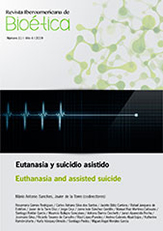A eutanásia e seus argumentos
DOI:
https://doi.org/10.14422/rib.i11.y2019.005Palavras-chave:
eutanásia, suicídio assistido, morte, sofrimento, autonomiaResumo
O autor procura esclarecer o significado atual de eutanásia, distinguindo-a de procedimentos aceitáveis do ponto de vista clínico, ético e legal, e apresenta de forma sumária os principais argumentos utilizados na reflexão e debate desta temática. Os argumentos principais a favor da eutanásia e/ou suicídio assistido são o alívio da dor e do sofrimento, considerados insuportáveis pelo paciente, e o respeito pela sua autonomia pessoal. Os principais argumentos contra são o da inviolabilidade da vida humana e o do risco de maus usos e abusos. Conclui defendendo que os argumentos a favor da eutanásia e/ou do suicídio assistido são insuficientes e insatisfatórios para justificarem a sua legalização.Downloads
Referências
Albert, M. (2019). Nota del editor invitado: Legalización de la eutanasia: lo que está en juego. Cuadernos de Bioética, 30(98), 19-21.
Antunes, J. L. (2002). Memória de Nova Iorque e Outros Ensaios. Lisboa: Gradiva.
Beauchamp, T. (2014). Justifying Physician-Assisted Death. In H. LaFollette (ed.), Ethics in Practice: An Anthology (4th ed.). West Sussex, UK: Wiley Blackwell.
Beauchamp, T., & Childress, J. F. (2001). Principles of Biomedical Ethics (5th ed.). Oxford: Oxford University Press.
Bekelman, J. E., Halpern, S. D., Blankart, S. D., et al. (2016). Comparison of site of death, health care utilization, and hospital expenditures for patients dying with cancer in 7 developed countries. Journal of the American Medical Association, 315(3), 272-283. DOI: https://www.doi.org/10.1001/jama.2015.18603
Berlinger, N., Jennings, B., & Wolf, S. M. (2013). The Hastings Center Guidelines for Decisions on Life-Sustaining Treatment and Care near the End of Life: Revised and Expanded Second Edition. New York: Oxford University Press.
Beuselinck, B. (2017). 2002-2016: Fourteen Years of Euthanasia in Belgium: First-Line Observations by an Oncologist. In D. A. Jones, C. Gastmans, & C. MacKellar (eds.), Euthanasia and Assisted Suicide: Lessons from Belgium. Cambridge: Cambridge University Press.
Billings, J. A., & Block, S. D. (1996). Slow euthanasia. Journal of Palliative Medicine, 12, 21-30.
Barreto, J. (1996). Suicídio Assistido. In L. Archer, J. Biscaia, & W. Osswald (coord.), Bioética (pp. 377-382). Lisboa: Verbo.
Brandão, J. L. (2014). Páginas de Suetónio: a morte de Augusto ou o “Mimo da vida”. Boletim de Estudos Clássicos (Universidade de Coimbra), 59, 61-73.
Brock, D. W. (2004). Life-Sustaining Treatment and Euthanasia: Ethical Aspects. In S. G. Post (Ed.), Encyclopedia of Bioethics (3rd ed.), vol. 3 (pp. 1410-1421). New York: Thomson Gale.
Cassell, E. J. (2004). The Nature of Suffering and the Goals of Medicine (2nd ed). New York: Oxford University Press.
Cohen-Almagor, R. (2013). First do no harm: pressing concerns regarding euthanasia in Belgium. International Journal of Law and Psychiatry, 36, 515-521.
Cohen-Almagor, R. (2017). Euthanizing People Who Are ‘Tired of Life’. In D. A. Jones, C. Gastmans, & C. MacKellar (eds.), Euthanasia and Assisted Suicide: Lessons from Belgium (pp. 188-201). Cambridge: Cambridge University Press.
Comissão Nacional de Controlo da Dor. (2011). Dor como 5.º Sinal Vital: Registo Sistemático da Intensidade da Dor. Lisboa: Direção-Geral da Saúde. https://www.dgs.pt/ficheiros-de-upload-3/dor-5-sinal-vital-folheto-pdf.aspx
Cruz, J. (2004). Morte Cerebral: Do Conceito à Ética. Lisboa: Climepsi Editores.
Cruz, J. (2012). Que Médicos Queremos?: Uma abordagem a partir de Edmund D. Pellegrino. Coimbra: Almedina.
Cruz, J. (2014). A relação médico-paciente na perspectiva de Pellegrino e Thomasma. Revista Brasileira de Bioética, 10(1-4), 10-22.
Dias, I. (2015). Envelhecimento e violência contra os idosos. Sociologia: Revista da Faculdade de Letras da Universidade do Porto, 15, 249-273.
Drane, J. (2003). More Humane Medicine: A Liberal Catholic Bioethics. Pennsylvania: Edinboro University Press.
Drane, J. (2010). Finding Relief from Suffering and Depression: The Role of Understanding and Faith. New York: St. Pauls.
Drickamer, M. A., & Melinda, A. L. (1997). Practical issues in physician-assisted suicide. Annals of Internal Medicine, 126, 146-151
Dutch Doctor Faces Trial in Landmark Euthanasia Case. https://bioethics.com/archives/47938 DELETE
Emanuel, E. J., Fairclough, D. L., Daniels, E. R., & Clarridge, B. R. (1996). Euthanasia and physician-assisted suicide: Attitudes and experiences of oncology patients, oncologists, and the public. The Lancet, 347, 1805-1810.
Gafo, J. (1996). 10 Palavras Chave em Bioética. Coimbra: Gráfica de Coimbra.
Gafo, J. (2011). Bioética. Lisboa: Paulus.
Garrafa, V., & Porto, D (2003). Interventional bioethics: a proposal for peripheral countries in a context of power and injustice. Bioethics, 17(5-6), 399-416.
Gawande, A. (2014). Being Mortal: Medicine and What Matters in the End. New York: Metropolitan Books.
Gorsuch, N. M. (2006). The Future of Assisted Suicide and Euthanasia. New Jersey: Princeton University Press.
Hooker, B. (2014). Rule-Utilitarianism and Euthanasia. In H. LaFollette (ed.), Ethics in Practice: An Anthology (4th ed.). West Sussex, UK: Wiley Blackwell.
International Association for the Study of Pain. https://www.iasp-pain.org/Education/Content.aspx?ItemNumber=1698
Kilner, J. F. (2004). Human Dignity. In S. G. Post (ed.), Encyclopedia of Bioethics (3rd ed.), vol. 2, (pp. 1193-1200). New York: Thomson Gale.
Keown, J. (2012). The Law and Ethics of Medicine: Essays on the Inviolability of Human Life. Oxford: Oxford University Press.
Keown, J. (2018). Euthanasia, Ethics and Public Policy: An Argument Against Legalisation (2nd ed.). Cambridge: Cambridge University Press.
Kure, J. (2011). Euthanasia – The “Good Death” Controversy in Humans and Animals. Croatia: InTech.
LaFollette, H. (2014). Ethics in Practice: An Anthology (4th ed.). West Sussex, UK: Wiley Blackwell.
Lindblad, A., Juth, N., Fürst, C. J., & Lynöe, N. (2010). When enough is enough; terminating life-sustaining treatment at the patient’s request: a survey of attitudes among Swedish physicians and the general public. Journal of Medical Ethics, 36(5), 284-289.
Marcoux, I., Mishara, B. L., Durand, C. (2007). Confusion between euthanasia and other end-of-life decisions: influences on public opinion poll results. Canadian Journal of Public Health, 98(3), 235-239.
Montero, E. (2017). The Belgian Experience of Euthanasia Since Its Legal Implementation in 2002. In D. A. Jones, C. Gastmans, C. MacKellar (eds.), Euthanasia and Assisted Suicide: Lessons from Belgium (pp. pp. 26-48). Cambridge: Cambridge University Press.
Nietzsche, F. (2006). Crepúsculo dos ídolos ou Como se filosofa com o martelo. Trad. Paulo César de Souza. São Paulo: Companhia das Letras.
Osswald, W. (2013). Sobre a Morte e o Morrer. Lisboa: Fundação Francisco Manuel dos Santos.
Pellegrino, E. D. (1992). Doctors Must Not Kill. In R. I. Misbin (ed.), Euthanasia: The Good of the Patient, the Good of Society (pp. 27-42). Maryland: University Publishing Group.
Pellegrino, E. D. (1994). Patient and physician autonomy: Conflicting rights and obligations in the physicianpatient relationship. Journal of Contemporary Health Law and Policy, 10, 47-68.
Pellegrino, E. D. (2000). Decisions at the End of Life: The Use and Abuse of the Concept of Futility. In J. W. Koterski (ed.), Life and Learning X Proceedings of the Tenth University Faculty for Life Conference (85-110). Washington DC: Georgetown University.
Pellegrino, E. D. (2000). Professionalism, profession and the virtues of the good physician. Mount Sinai Journal of Medicine, 69(6), 378-384.
Pellegrino, E. D. (2006). Toward a Reconstruction of Medical Morality. The American Journal of Bioethics, 6(2), 65-71.
Pellegrino, E. D., & Thomasma, D. C. (1988). For the Patient’s Good: Toward the Restoration of Beneficence in Health Care. New York: Oxford University Press.
Pereira, J. (2011). Legalizing euthanasia or assisted suicide: the illusion of safeguards and controls. Current Oncology, 18(2): e38-e45.
RENTEV. (2014). Registo Nacional de Testamento Vital. Diretiva Antecipada de Vontade. https://spms.min-saude.pt/wp-content/uploads/2014/06/Rentev_form_v0.4.12.pdf
Santos, L. (2009). Ajudas-me a Morrer? A Morte Assistida na Cultura Ocidental do Século XXI. Lisboa: Sextante.
Sepúlveda, C., Marlin, A., Yoshida, T., & Ullrich, A. (2002). Palliative Care: The World Health Organization’s Global Perspective. Journal of Pain and Symptom Management, 24, 91-96.
Serrão, D. (1996). Eutanásia e Distanásia. In L. Archer, J. Biscaia, & W. Osswald (coords.), Bioética (pp. 382-385). Lisboa: Verbo.
Serrão, D. (1998). Ética das Atitudes Médicas em Relação com o Processo de Morrer. In D. Serrão, R. Nunes (coords.), Ética em Cuidados de Saúde (pp. 83-92). Porto: Porto Editora.
Serrão, D. (2010). Os Médicos e o Processo de Morrer. In D. Serrão, Na Academia das Ciências: Comunicações Regimentais, Elogios Académicos, Outras Participações (pp. 107-115). Porto: Edição de Autor.
Sgreccia, E. (2009). Bioética, Eutanásia e Dignidade da Morte (cap. XV). In Manual de Bioética: Fundamentos e ética biomédica (pp. 853-920). Cascais: Princípia.
Shaw, D. M. (2015). Saving Lives with Assisted Suicide and Euthanasia: Organ Donation After Assisted Dying. In
M. Cholbi, J. Varelius (eds.), New Directions in the Ethics of Assisted Suicide and Euthanasia. International Library of Ethics, Law, and the New Medicine, vol. 64, (pp. 185-192). Switzerland: Springer.
Silva, M. O. (2017). Eutanásia, Suicídio Ajudado, Barrigas de Aluguer: Para um debate de cidadãos. Alfragide: Editorial Caminho.
Smith, W. J. (2016). Culture of Death: The Age of “Do Harm” Medicine (2nd ed.). New York: Encounter Books.
Somerville, M. A. (2014). Death Talk: The Case against Euthanasia and Physician-Assisted Suicide. Montreal & Kingston: McGill-Queen’s University Press.
Suarez-Almazor, M. E., Newman, C., Hanson, J., & Bruera, E. (2002). Attitudes of terminally ill cancer patients about euthanasia and assisted suicide: predominance of psychosocial determinants and beliefs over symptom distress and subsequent survival. Journal of Clinical Oncology, 20(8), 2134-2141.
Sulmasy, D. P., Travaline, J. M., Mitchell, L. A., & Ely, E. W. (2016). Non-faith-based arguments against physicianassisted suicide and euthanasia. The Linacre Quarterly, 83(3), 246-257.
Ten Have, H. (2009). Eutanásia: Objecções Morais. In A Condição Humana: Ética, Saúde e Interesse Público (pp. 319-334). Alfragide: Publicações D. Quixote.
Vanderpool, H. Y. (2004). Life-Sustaining Treatment and Euthanasia: Historical Aspects. In S. G. Post (ed.), Encyclopedia of Bioethics (3rd ed.), vol. 3, (pp. 1421-1432). New York: Thomson Gale.
Warnock, M., & Macdonald, E. (2008). Easeful Death: Is There a Case for Assisted Suicide? Oxford: Oxford University Press.
World Medical Association. WMA Declaration on Euthanasia. https://www.wma.net/policies-post/wma-declaration-on-euthanasia/
Wyatt, J. (2009). Matters of Life & Death: Human dilemmas in the light of the Christian faith. Nottingham: Inter-Varsity Press.
Downloads
Publicado
Como Citar
Edição
Seção
Licença
Los autores de artículos aceptados en la Revista Iberoamericana de Bioética conservan los derechos de propiedad intelectual sobre sus trabajos y otorgan a la revista los permisos de distribución y comunicación pública de los mismos, consintiendo que se publiquen bajo una licencia Creative Commons Atribución-NoComercial-SinDerivadas 4.0 Internacional. Se recomienda a los autores publicar su trabajo en Internet (por ejemplo en páginas institucionales o personales, repositorios, etc.) respetando las condiciones de esta licencia y citando debidamente la fuente original.


















